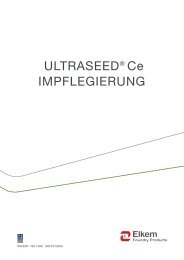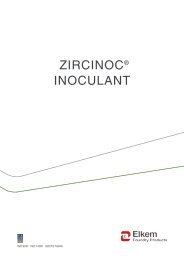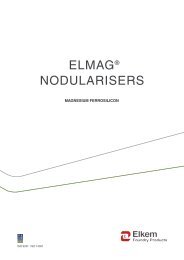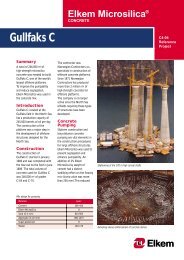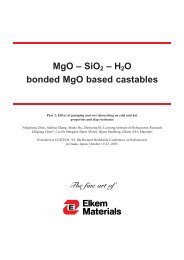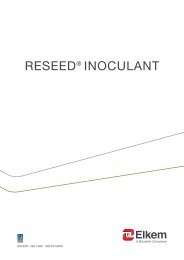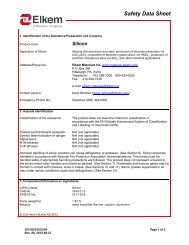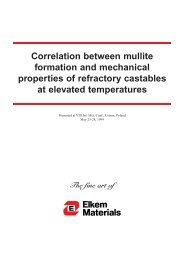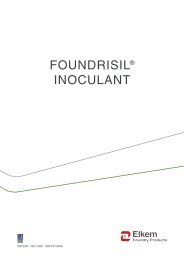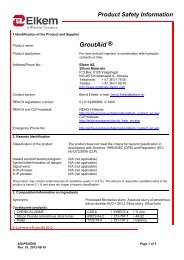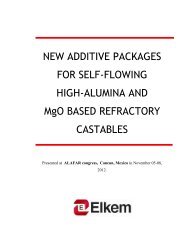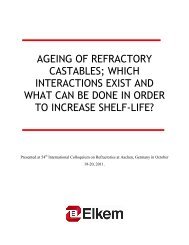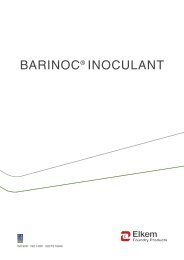2.I.2_CSSC6 Full Paper Anne karin Soiland - Elkem
2.I.2_CSSC6 Full Paper Anne karin Soiland - Elkem
2.I.2_CSSC6 Full Paper Anne karin Soiland - Elkem
You also want an ePaper? Increase the reach of your titles
YUMPU automatically turns print PDFs into web optimized ePapers that Google loves.
SOLAR SILICON FROM A METALLURGICAL ROUTE BY ELKEM SOLAR - A VIABLE ALTERNATIVETO VIRGIN POLYSILICON<strong>Anne</strong>-Karin Søiland * , Jan Ove Odden, Bjørn Sandberg, Kenneth Friestad, John Håkedal, Erik Enebakk and SteinarBraathenELKEM SOLAR, Fiskaaveien 100, 8040 Vågsbygd, 4675 Kristiansand,*Corresponding author: Tel: +47 982 12 777, Fax: +47 38 01 70 40, E-mail: anne-<strong>karin</strong>.soiland@elkem.noABSTRACT: <strong>Elkem</strong> Solar Silicon® (ESS) was commercialized in 2009 and is produced via a metallurgicalrefining route. As a feedstock material, ESS has the potential to meet the offensive cost targets for the PVindustry. The characteristics in terms of chemical composition is clearly different from the conventionalfeedstock, polysilicon. Nevertheless the cell efficiencies obtained on multi (17-17.5%) and mono (18.3%) cellsare comparable to polysilicon references. We also present data obtained from the field (India) on modules solelybased on ESS. These data are compared to polysilicon reference modules. Both types of modules show similarperformance. A tendency of increased performance of the ESS modules is observed, under high irradiationconditions, and is a topic for further investigations. An indication of the stability of older modules based on SolarGrade Silicon from <strong>Elkem</strong> is also considered. On the basis of these results there is no reason to expect thatmodules based on ESS differs from other commercial modules based on polysilicon. Thus, ESS is a viablealternative to the conventional polysilicon, but with the additional benefit of lowering specific energy use andcost per kWh.Keywords: Solar Grade Silicon Feedstock, Multicrystalline wafers, monocrystalline wafers, Solar cells, Modules1 INTRODUCTIONThe expansive growth of the PV industry in thebeginning of this millennium initiated the urge for aproper silicon feedstock [1], which at that time was basedon scrap material from the semiconductor industry.During the last decade research and developments havelead to several types of silicon feedstock dedicated to thePV industry. These are based on routes involving gaseouschlorosilanes, like “relaxed Siemens”, Fluidized BedReactor processes, as well as more recent Metallurgicalrefining routes. <strong>Elkem</strong> Solar started commercialproduction in 2009, hence <strong>Elkem</strong> Solar Silicon® (ESS)entered the market [2]. The production of ESS ischaracterized by a low energy use; 75% lower thanconventional Siemens process [3]. The industrial scaleenergy pay back time (EPBT) for ESS has beenestimated to 1.3 months, and with a green house gasemission (GHG) rate calculated to 25% of the bestSiemens case [4]. The <strong>Elkem</strong> Solar process route isflexible with several possibilities for recycling ofcustomer cuts.The gas phase routes based on Siemens bell jarreactor yields more or less a product of similar chemicalpurity. This is not the case for the metallurgical refiningroutes, which differ largely in their manufacturingmethods. Despite these differences, the term UpgradedMetallurgical Grade Silicon (UMG-Si), is frequently usedto describe the silicon products from the variousmetallurgical refining routes. Since this is not a unifiedproduct of same chemical purity, the annotation UMG-Sican be quite misleading.The starting point of both gas phase- and <strong>Elkem</strong> Solarrefining route is the same; Primary Metallurgical GradeSilicon from the smelting furnace. Due to the processdifferences the products (ESS and polysilicon) aredifferent in their chemical purity and form. Through theingot/wafer step this difference is reduced. This is due tothe refining in the directional solidification, but alsobecause of the contamination taking place due to reactionsin the furnace chamber and interactions with the crucibleand coating [5, 6]. The difference is further reduced in thecell process because of the phosphorus diffusion step whichgetter impurities. Thus, in a sense the two materialsapproach each other through the process chain towards themodule.The viability of ESS as a feedstock to the PV industry ismuch defined by the cost (cost/kWh) for the final solarsystem performance. We will in the following text presentour experiences and evaluations with ESS through theprocess chain and up to module testing in the field.2 PRODUCT CHARACTERISTICS ANDANALYSES2.1 <strong>Elkem</strong> Solar Silicon®The <strong>Elkem</strong> Solar process route starts with the production ofMetallurgical Grade silicon, which is followed by threepurification steps as described by Odden and Søiland [7].The product ESS is characterized as a compensatedsilicon, due to the presence of both acceptors (N A ) anddonors (N D ). Compared to virgin polysilicon the ESSdiffers also in its form, since it is delivered as bricks, figure1. Since these bricks are the result of the last purificationstep, which is a directional solidification, the brick itself isnot a homogeneous product. Therefore it contains a certainconcentration gradient for most elements. As a consequencethe whole bricks should be used in ingot crystallization.TopBottomConcentrationgradient due tosegregation
Figure 1: A typical ESS brick showing theconcentration gradientIn 2011 a specification for feedstock materials for the PVindustry, the SEMI PV17-0611, was released [8].According to this specification ESS meets therequirements of the category IV material, see Table 1.ElementsSpecificationSEMI PV17-0611<strong>Elkem</strong> SolarSilicon®Typical valuesBoron TargetTolerance≤ 0.38 ppmw± 0.06 ppmw≤ 0.20 ppmw± 0.05 ppmwPhosphorus TargetTolerance≤ 0.79 ppmw± 0.17 ppmw0.62 ppmw± 0.15 ppmwCarbon ≤ 43 ppmw 25 ppmwAluminum -- ≤ 0.01 ppmwTransitionand PostTransitionmetals Ti,Cr, Fe, Ni,Cu, Zn, MoAlkaliandEarthAlkalimetalsNa, K,Ca≤ 200 ppba≤ 4000 ppba≤ 50 ppba≤ 200 ppbaTable 1: The specification for category IV of the SEMIPV17-0611 compared to typical values in terms ofchemical analyses of the ESS SoG-Si feedstock.2.2 Analytical challengesWhen producing a feedstock intended to the PV industrythe analytical work is of high priority, since the tolerancelevels are so small. There are several challenges bothwith regard to the analyses themselves, but alsoconcerning the sampling of large product volumes.Much effort has been made at <strong>Elkem</strong> Solar to theanalytical work and to achieve good sampling techniques.Particularly, the analyses of dopant elements have beengiven much attention, because these elements determinekey parameters like resistivity and yield in the ingotprocesses. The analyses of boron is performed by ICP-MS (quadropol) at <strong>Elkem</strong> Solar. We have performedseveral quality measurements as Isotope Dilution, as wellas, comparisons with external laboratories using differentmeasurement techniques (see Table 2 and 3). Thesystematic errors identified are too small to affectmeasurement outcome and thus the boron concentrationreported by ES is considered to be analytically accurate.However, <strong>Elkem</strong> is continuously working on theimprovement of quantification methods in use.Sample B concentration /ppmwIDMS (n=4, 1 SD)John Si 0.34 ±0.02 0.37 ±0.02V2 0.22 ±0.02 0.24 ±0.01M4 0.24 ±0.01 0.27 ±0.01B concentration / ppmwStand. ICP-MS (n=18, 1 SD)Table 2: Boron quantification using isotope dilution.Bottom 0.20 0.22 0.23Top 0.26 0.25 0.26Table 3: Analyses of sample material and comparison with externallaboratoriesFor a solar grade feedstock it is critical to ensure that themetallic impurity content is within given specification. Wehave performed analyses of the metallic impurity content inESS at external laboratories, with sampling from longerproduction periods. Shown in Table 4 below is the GDMSresults (Shiva EAG Labs) from sampling over a productionperiod of six months. Neutron Activation Analysis (NAA)from Missouri University Research Reactor (MURR),SemiSol Analytik GmbH and Wacker Chemie AG are alsoincluded in this table. Figure 2 show how the sampling fromthe bricks were performed.Figure 2: Sampling from the ESS brick; for NAA the topsample (normally highest imp. content), and sampling forGDMS the dotted area (reflecting the bulk concentration).Method Na K Ca Ti Fe Ni Cu Zn GaNAA 1 /ppbwGDMS 2 /ppbw0.3
Resistivity / ohm cm(a)3Resistivity / ohm cm(b)3210210ESS0 0,2 0,4 0,6 0,8 1Fraction solidified / f sFigure 3: Resistivity profiles for (a) ingot with 100%ESS and added group III element and (b) standardpolysilicon ingot boron doped and ingot with 20% ESSmixed with 80% virgin polysilicon3.2 Carbon (substitutional) and Oxygen (interstitial)contentsBoth carbon and oxygen are elements that are readilyincorporated into the melt during ingot solidification dueto interactions with both crucible/coating and atmosphereabove the melt surface [5,6]. Oxygen levels in the ingotsare generally higher for monocrystals than formulticrystals because there is no lining between the meltand the silica crucible.The interstitial oxygen seems to be process dependentrather than feedstock dependent for both themulticrystalline solidification process and the Cz-monoprocess, see figure 4. There is no significant differencebetween ESS based ingots and the references and thereis no increase in O i going from 33% ESS to 50%ESS. For multicrystalline ingots similar results areobserved, Figure 5.Contents of O i tail end / ppma0 0,2 0,4 0,6 0,8 120181614121086420Polysilicon B_dopedESSFraction solidified / f s33% ESS_tail 50% ESS_tailReferences_tail 33%ESS_seed50%ESS_seed References_seed0 2 4 6 8 10 12Crystal no.Figure 4: FTIR interstitial oxygen contents from seed- andtail-end for various crystals; 33% ESS, 50% ESS andreferencesInterstitial Oxygen / ppma(a)Interstitial oxygen / ppma121086420121086420Brick 3Brick 4Brick 7Brick 140 100 200 300 400 500 600Wafer number from bottom0 100 200 300 400 500 600Wafer number from bottomBrick 3Brick 4Brick 7Brick 14Figure 5: Contents of interstitial oxygen (O i in ppma)measured on wafers ranging from bottom to top positions inall types of bricks (corner, side and centre) in an ingot, (a)100% ESS ingot and (b) standard polysilicon ingotThe substitutional carbon contents in Cz-monocrystalsshow a feedstock dependency, see figure 6. However, thelevel of substitutional carbon is below the solid solubilitylimit for carbon in silicon (7-8 ppma) [13, 14] along theingot.For multicrystalline wafers the measurements ofsubstitutional carbon show no difference between the 100%ESS and 100% virgin polysilicon ingot, see figure 7. Thisindicates that the level of contamination is more dominatingin the multicrystalline ingot process than in themonocrystalline ingot process. However, it is certainlydependent on the different furnace and process conditions,which may vary substantially in the case of multicrystallineingot manufacturing.Contents of C s tail end / ppma10987654321033% ESSTM_tail 50% ESSTM_tailReferences_tail50%ESS_seed33%ESS_seedReferences_seed0 2 4 6 8 10 12Crystal no.Figure 6: FTIR substitutional carbon contents from (a) seed
ujjend for various crystals; 33% ESS, 50% ESS andreferences, modeled results for (b) tail end for variouscrystals; 33% ESS, 50% ESS and references.Substitutional carbon / ppma(a)Substitutional carbon / ppma(b)1210864201210864200 200 400 600Wafer number from bottomFigure 7: FTIR substitutional carbon contents formulticrystalline wafers (a) 100% ESS ingot, variousbricks (b)standard polysilicon based ingot, various bricks.4 CELL CHARACTERISTICS4.1 Multicrystalline and monocrystalline cellsBrick 3Brick 4Brick 7Brick 14Brick 3Brick 4Brick 7Brick 140 200 400 600Wafer number from bottomOne focus of <strong>Elkem</strong> Solar has been to show that solarcells made from ESS are comparable with solar cellsmade from virgin polysilicon. In this sense proving thatthe purity level in ESS is sufficient for the PV industry.The first large scale test results with ESS based waferswere presented in 2008 and showed comparable cellefficiencies for ESS mixed up to 100% [2]. Since,then the ESS product has been further improved, witha lowering of boron and phosphorus levels [15]. <strong>Elkem</strong>Solar has supervised the quality of wafers from differentcustomers by continuous testing at The InternationalSolar Energy Center (ISC) in Konstanz. Figure 8 and 9below, show the results obtained on multicrystalline andmonocrystalline cells processed at ISC Konstanz and forthe multicrystalline cells also at industrial cell producers.For the latter we see quite much variation from one waferproducer to another indicating the importance of a goodwafer quality with large grains and low dislocationdensities. It is important to note that there is also a timedifference for the processing of these wafers. The oldestdata are from 2010 and the most recent from 2012, so thevariations in cell efficiencies are also due to theimprovement of the cell processing itself in this period.For monocrystalline cells the variations are much lessbetween different producers showing the uniformity of thiswafer type.Efficiency / %Figure 8: Cell efficiencies obtained by different producersusing ESS at different blend-in ratios. Polysiliconreference data are provided where available, and thestandard deviations for all batches are indicated. The resultsare based on cells processed by ISC Konstanz or industrialcell producers using their standard cell line in a similar wayas for polysilicon material.Efficiency / %18,017,517,016,516,015,515,020,019,519,018,518,017,517,016,516,0ESS containingPoly Ref.Wafer producer (A-I) and %ESS mix-in ratioMono_ESS basedMono_ref0-0.2 0.2-0.4 0.4-0.6 0.6-0.9Fraction solidified / fsFigure 9: Cell efficiencies as function of fraction solidifiedfor crystals from a mix of 50% ESS and 50% virginpolysilicon, and crystals from 100% virgin polysilicon. Theresults on mono (ESS) are the average obtained fromwafers from 4 crystals grown at four different crystalgrowers and the results on mono (ref) are from two differentmonocrystals grown at two different crystal growers, withtheir standard deviations. All wafers have been processed atthe standard industrial cell line in ISC-Konstanz.Concerning cell characteristics as V OC , I SC and FF, wesee, as has been reported previously on compensatedmaterial, that V OC tend to be higher due to a generally lowerresistivity, while the I SC tend to be lower [16]. This is shownin Table 5, where cells were processed at two differentindustrial cell producers. Furthermore, we have alsoobserved a slight tendency of higher fill factors on our cellscompared to conventional polysilicon based cells. Thisobservation was also reported by Dubois et al. [17] andattributed to dopant compensation improving the metalcontact formation.There can be slight differences in the cell characteristics,particularly V OC , I SC and FF, for cells based on compensated
feedstock like ESS, but this is also closely linked to theresistivity target of the wafers. In many cases thesedifferences counterbalance each other which results incomparable cell efficiencies, but may have an impact onmodule level.ProducerHProducerIMaterial η / % I SC /AESS 100% 17.04 8.44Poly ref. 17.14 8.53ESS 100%ESS 60%Poly ref.17.3517.5117.438.518.578.63V OC /V0.6250.6240.6270.6290.625FF78.5978.3379.1578.9978.46Table 5: Output in detail from the latest cell processinginvolving ESS. Results for polysilicon referencematerial, casted and wafered by the same producers andprocessed parallel to the ESS material, are included.All results are for batches of >500 wafers processed intocells in standard industrial cell lines without any specialtreatment included.4.2 Light Induced Degradation (LID)In compensated feedstock material like ESS the boronconcentration for a given resistivity is higher compared topolysilicon based wafer of same resistivity. Thus, askepticism against compensated feedstock has beenconnected to LID caused by BO complexes and theassumption that this is increased in this type of cells.During the last years this topic has been given quite muchattention by various research institutions. Still themechanisms behind LID due to boron-oxygen complexesseem unclear. Different investigations have indicatedthat the BO-complex formation in compensated silicondepend rather on the net dopant concentration than on thetotal boron concentration [18, 19]. However, LID hasalso been observed in n-type compensated cells andGeilker et al. [20] suggested that it depended on thecompensation ratio. In both cases, it seems that thecompensation itself plays some kind of role in theformation of the BO-complexes in compensated siliconwafers. It has also been proposed an alternative model forthe defect, that it consists of interstitial boron rather thansubstitutional boron, and an interstitial oxygen dimer(B i O 2i ) [21]. This model can explain also observationsmade on n-type compensated material [22].What should also be addressed when analyzing LIDin compensated cells is that the measurement methoditself varies quite much between different cell producersand between research institutes. Amongst other the lightintensity and exposure time varies. This makes it difficultto compare results. A standard method for thesemeasurements seems to be lacking.Typical LID results for mono- and multicrystallinecells based on ESS are shown in Figure 10. Thedegradation measurements have been performed by ISCKonstanz under an illumination of 1 sun at 25°C for 48hours. For monocrystalline cells the absolute efficiencyloss range from 0.1 to 0.5 %, there is a decreasingtendency from seed to tail end. Also for themulticrystalline cells a decreasing tendency is observedfrom bottom to top. Whether this is solely due to thedecreasing oxygen content or also connected to theincreasing compensation is not known. In both cases theLID loss is comparable to standard polysilicon based cells.Abs. effcicency loss %(a)LID relative efficency loss / %(b)10,90,80,70,60,50,40,30,20,1021,510,500 2 4 6 8Position along crystal lengthFigure 10: (a) Absolute efficiency loss due to LID formonocrystal based on 50% ESS in the charge as afunction of position in the crystal, from seed end to tail end(b) Relative efficiency loss caused by Light InducedDegradation (Rel. LID) measured on solar cells originatingfrom wafers ranging from bottom to top positions in alltypes of bricks (corner, side and centre) in an ingot.5 MODULE TESTINGCrystal 1Crystal 2Crystal 3Crystal 4Ref 1Ref 2Brick pos. 1Brick pos. 9Brick pos. 100 100 200 300 400 500Wafer number from bottom5.1 Module testing in the fieldLong term degradation of solar modules is expected to becaused mostly by components other than the solar cellmaterial, the silicon, itself. Nevertheless, since field testresults on solar modules made of compensated siliconfeedstock are quite scarce, <strong>Elkem</strong> Solar participates inseveral on-going research programs covering this area. Solarmodule test stations in the field are put up in India, Japan, aswell as two local stations in Norway. In all the test stationsESS-based solar modules are standing side by side withcomparable and otherwise equal polysilicon referencemodules. In the following results from these test stations arepresented.5.2 Module degradation over timeFigure 11 below presents results on module degradationfrom the initial LID, seen within the very first hours ofoperation, to certified characteristics obtained annually byPhotovoltaic Institute in Berlin (PI Berlin) for certainmodules. In addition degradation of the very first demomodules made of <strong>Elkem</strong> Solar Silicon from the mid 1980sand mid 1990s have been measured and implemented infigure 10.
Relative efficiencyRelative efficiency10099989796951009590858075ESS 100%POLY REF0 0,5 1 1,5 2 2,5 3YearsDemo module 1Demo module 2700 5 10 15 20 25 30YearsFigure 11: Change in relative efficiency over timemeasured on different 100% ESS-based solar modules.The more recently produced modules [green symbols inthe top left corner of lower part] are highlighted in theupper part. Demo module 1 gives the degradation for atest module based on <strong>Elkem</strong> SoG-Si from 15 years back,and Demo module 2 indicates the average for smallerdemo modules made from <strong>Elkem</strong> solar grade silicon from27 years back. The solid lines in (b) correspond to alinear long term degradation of 0.5% and 1% per year,respectively, and the solid line in (a) correspond to 0.5%per year.So far no difference can be seen between the ESSbased solar modules and the Polysilicon referencemodules, neither on the initial LID nor the more longterm degradation. The modules studied seem to bedegrading at a rate of less than 0.5% per year. For theolder demo modules a somewhat larger degradation isseen, however still very reasonably considering the timeof production.Some interesting preliminary results from the test stationin India have appeared during the first months ofmonitoring. What has been observed is an improvedperformance of the ESS based modules as a function ofsolar irradiance. The ESS modules have beenproducing best during the time of days where theirradiation and electricity generation is the highest. Dueto this phenomenon the ESS modules have generatedmore kWh than the polysilicon reference so far. Theseaspects are topics for continued research and giveimportant prospects when the cost/kWh is to becalculated for solar systems.6 CONCLUSIONSThe total content of transition and post transitions metalsin ESS is below 50 ppba, and ESS meets therequirements given in SEMI PV017 for category IV forvirgin silicon feedstock materials for PV.As a compensated feedstock ESS gives possibilities forflat resistivity profiles in ingots, by different strategies: inlinedoping or doping with group III elements or lower mixin% for customers targeting a more uniform resistivitydistribution.The interstitial oxygen contents in wafers based on ESSseem to be process dependent and not feedstock dependentfor both multi- and monocrystalline wafers. LID onmulticrystalline cells are in average for a brick below 0.8%relative efficiency loss, while for monocrystalline cells it istypically in the range 1-3% relative loss. This is in the samerange as polysilicon based cells.Cell efficiencies obtained on both multi- andmonocrystalline wafers from different producers arecomparable to references, with 17-17.5% (recent) on multiand 18.3% on mono.Testing of modules based solely on ESS as feedstockshow a degradation of around 0.5% per year, and similarinitial loss (LID) as the reference modules. Monitoring ofmodule performance in the field (India) show a tendency ofimproved performance, compared to polysilicon basedmodules, under high irradiation conditions. To this end,<strong>Elkem</strong> Solar is working actively with different researchinstitutes to carry out various cell and module long-termtests, with the aim of exploiting its product’s potential evenfurther than has been indicated in this paper.In conclusion, ESS, has as feedstock, differentcharacteristics than virgin polysilicon due to their differentmanufacturing processes. However, the achievements oncell and module level, show that ESS should be a viablealternative to virgin polysilicon.5 ACKNOWLEDGMENTSWe would like to thank Dr. Kristian Peter and Pirmin Preisat ISC Konstanz, and Dr. Stefan Rein, Fabian Fertig andJuliane Geilker at Fraunhofer ISE for research collaborationand fruitful discussions. The Norwegian Research Council isthanked for funding under contract no.: 200721 (BIPproject:”Fieldand accelerated lab-testing”).6 REFERENCE[1] K. Friestad, C. Zahedi, E. Enebakk, M.G. Dolmen, J.Heide, K. Engvoll, T. Buseth, R. Tronstad, C.Dethloff, K.Peter, R. Kopecek, I. Melnyk, 19 th EUPVSEC, Paris, 2004[2] V. Hoffmann, K. Petter, J. Djordjevic-Reiss, E. Enebakk,J.T. Håkedal, R. Tronstad, T. Vlasenko, I. Buchoskaja, S.Beringov and M. Bauer, 23 rd European Photovoltaic SolarEnergy Conference, Valencia, 2008[3] J. O. Odden, G. Halvorsen, H. Rong and R. Gløckner,Silicon for the Chemical and Solar Industry IX, Oslo, 2008[4] S. Braathen, E. Enebakk, R. Gløckner, M. J. de Wild-
Schölten, P. Preis and K. Peter, SolarCon China,Shanghai, 2012[5] F. Schmid, C. P. Khattak, T. G. Digges and L.Kaufmann, J.Electrochem.Soc.: Electrochemical Scienceand Technology, Vol.126, No.6, 935-938, 1979[22] B. Lim, F. Rougieux, D. MacDonald, K. Bothe and J.Schmidt, Journal of Applied Physics 108, 2010[6] A-K. Søiland, E. J. Øvrelid, T. A. Engh, O. Lohne, J.K. Tuset and Ø. Gjerstad, Materials Science inSemiconductor Processing, Vol. 7, 39-43, 2004[7] J. O. Odden, A-K. Søiland, E. Enebakk, S. Braathen,B. Sandberg and K. Friestad, Photovoltaics International,45-49, May 2012[8] SEMI PV17-0611, ”Specification for Virgin SiliconFeedstock Materials for Photovoltaic Applications”, June2011[9] Patent no.: WO2008/112598 A2[10] J. Kraiem, R. Einhaus and H. Lauvray, 34th IEEEConference, Philadelphia, 2009[11] Patent no.: WO2007/001184 A1[12] S. Riepe, C. Schmid, J. Haunschild, R. Zaidler, F.Fertig and S. Reber, CSSC5, Boston, 2011[13] T. Nozaki, Y. Yatsurugi and N. Akiyama, J.Electrochem.Soc.: Solid State Science, Vol. 117, No. 12,1566-1568, 1970[14] A. R. Bean and R. C. Newman,J.Phys.Chem.Solids., Vol.32, 1211-1219, 1971[15] A-K. Søiland, K. Peter, P. Preis, R. Søndenå, I.Odland, E. Enebakk and R. Tronstad, CSSC5, Boston,2011[16] K. Peter, R. Kopecek, E. Enebakk, A-K. Søiland andS. Grandum, 25th European Photovoltaic Solar EnergyConference and Exhibition, Valencia, 2010[17] S. Dubois, J. Veirman, N. Enjalbert and F. Tanay,Presentation: “ Dopants in compensated SoG-Si”, lectureat NTNU, 2012[18] R. Kopecek, J. Arumughan, K. Peter, E. A. Good, J.Libal, M. Acciarri, and S. Binetti, Proceedings of the 23 rdEuropean Photovoltaic Solar Energy Conference,Valencia, Spain, 2008, p. 1855[19] D. MacDonald, F. Rougieux, A. Cuevas, B. Lim, J.Schmidt, M. Di Sabatino and L.J. Geerligs, Journal ofApplied Physics 105, 2009[20] J. Geilker, W. Kwapil, and S. Rein, Journal ofApplied Physics 109, 2011[21] V.V. Voronkov and R. Falster, Journal of AppliedPhysics 107, 2010



